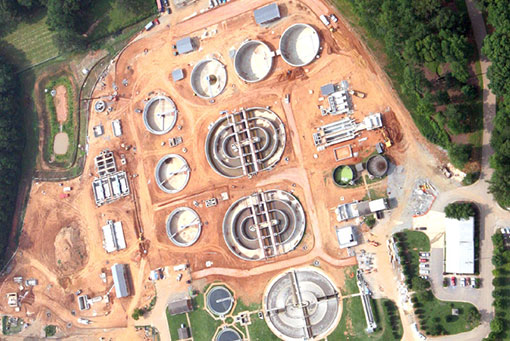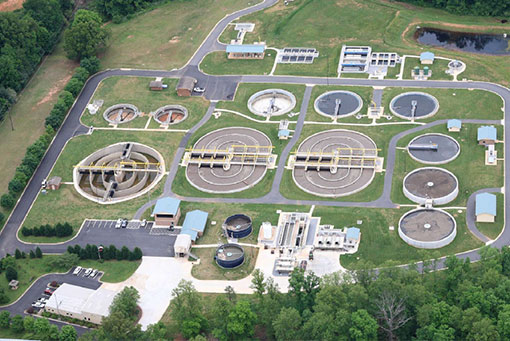Wastewater Treatment
Cumming Utilities utilizes the Evoqua Envirex Orbal biological wastewater treatment process to remove contaminants from wastewater, primarily from household sewage. This process includes physical, chemical, and biological treatment processes that produce a high quality of effluent which is discharged into Big Creek near Bethelview Road.
Raw sewage is pumped to the facility’s headworks where grit and grease are removed via an aeration process that causes the grit to fall to the bottom of the tank and the grease to float to the top. These by-products are then removed from the facility and hauled to a sanitary landfill.
The pretreated sewage is then sent to the aeration basin where aerobic and facultative microorganisms are cultivated to remove specific pollutants such as nitrogen, phosphorous, and carbon-based compounds. This process is a natural process which is enhanced by aeration and mixing within zones of varying oxygen concentrations. During the process, the microbes consume approximately 90% of the human waste and other pollutants present in the sewage.
The mixture of microorganisms, called Mixer Liquor Suspended Solids (MLSS), is then discharged into the rim-flow clarifiers where gravity causes the heavier microogranisms to fall to the bottom of the tank and allows the clear water to flow over weirs and eventually into the flocculation and sedimentation basins. Flocculation is accomplished with mechanical mixers and sedimentation (or settling) is enhanced by plate settlers.
The settled water is then sent to the facility’s sand filters where final polishing of the water takes place. The filtered water is then discharged into an ultraviolet light contact chamber where disinfection takes place via ultraviolet irradiation.
The disinfected water is then aerated and discharged into Big Creek.
Experience
The City of Cumming is no newcomer to the wastewater treatment field. For over 50 years the City has addressed Cumming’s need for wastewater treatment and environmental integrity. The City built the area’s first wastewater treatment facility, a five-acre oxidation pond, in 1963. Several years later in 1991, the City moved the treatment facility and constructed a state-of-the-art 2 Million-Gallon-Per-Day (2 MGD) Advanced Water Reclamation Facility on Bethelview Road. In 1999, the City expanded the Bethelview Road facility to 3 MGD. Currently, the Bethelview Road AWRF is designed to treat an average of 8 MGD of domestic wastewater. The ability to offer this level of service empowers the City to welcome quality growth and development to the area.

Construction of the City’s 8 MGD Advanced Water Reclamation facility began in 2006 and was completed in 2008

The City has received several awards for many years of complete compliance with tour NPDES Permit from both local and state organizations such as the Georgia Association of Water Professionals (GAWP) and the National Association of Clean Water Agencies (NACWA).
